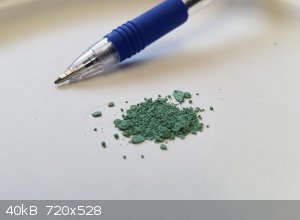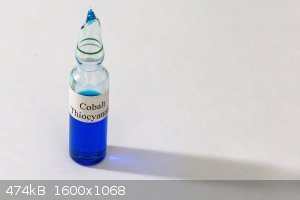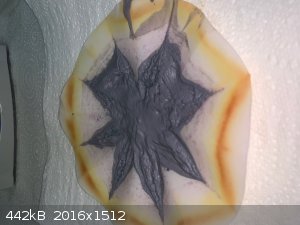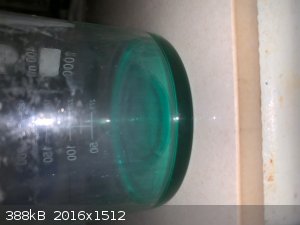| Pages:
1
2
3 |
NEMO-Chemistry
International Hazard
    
Posts: 1559
Registered: 29-5-2016
Location: UK
Member Is Offline
Mood: No Mood
|
|
Cobalt compounds
I have done a few copper compounds now, including basic carbonate, and asprinate (sorry to those that hate the name). I want to now do some Colbalt
ones starting point is Colbalt chloride.
Can Colbalt form Colbat asprinate? i cant find much on it. I am aware the risks with Colbalt compounds, my scale is small and just enough to fill a
25ml vial for display.
|
|
|
DraconicAcid
International Hazard
    
Posts: 4355
Registered: 1-2-2013
Location: The tiniest college campus ever....
Member Is Offline
Mood: Semi-victorious.
|
|
I don't think cobalt forms an aspirinate, but you can make potassium tricarbonatocobaltate(III) which is cool.
Please remember: "Filtrate" is not a verb.
Write up your lab reports the way your instructor wants them, not the way your ex-instructor wants them.
|
|
|
VSEPR_VOID
National Hazard
   
Posts: 719
Registered: 1-9-2017
Member Is Offline
Mood: Fullerenes
|
|
If you need ideas you can check this site
http://onyxmet.com/?route=product/category&path=69_93_27...
Within cells interlinked
Within cells interlinked
Within cells interlinked
|
|
|
DraconicAcid
International Hazard
    
Posts: 4355
Registered: 1-2-2013
Location: The tiniest college campus ever....
Member Is Offline
Mood: Semi-victorious.
|
|
Ooooh. Pretty.
Please remember: "Filtrate" is not a verb.
Write up your lab reports the way your instructor wants them, not the way your ex-instructor wants them.
|
|
|
NEMO-Chemistry
International Hazard
    
Posts: 1559
Registered: 29-5-2016
Location: UK
Member Is Offline
Mood: No Mood
|
|
I prefer to make things i can pronounce easily lol, dosnt exactly trip off the tongue does it!! Nasty colour for a colbalt salt!
Thx for the link VV.
Slowly getting my pointless but colorful compound collection done.
I got 100 nice tubes with screw lids from China last week, only to trip over the step carrying them to the lab  . .
Might just be me being tight, but those tubes are costing more by the day!
WOW i could spend a fortune on that site!! Colbalt has some amazing colours.
[Edited on 28-11-2017 by NEMO-Chemistry]
|
|
|
DraconicAcid
International Hazard
    
Posts: 4355
Registered: 1-2-2013
Location: The tiniest college campus ever....
Member Is Offline
Mood: Semi-victorious.
|
|
COBALT only has one L.
And it might not be a nice colour (I think it's a nice, very dark green), but it is a useful starting material for cobalt(III) complexes.
[Edited on 28-11-2017 by DraconicAcid]
Please remember: "Filtrate" is not a verb.
Write up your lab reports the way your instructor wants them, not the way your ex-instructor wants them.
|
|
|
NEMO-Chemistry
International Hazard
    
Posts: 1559
Registered: 29-5-2016
Location: UK
Member Is Offline
Mood: No Mood
|
|
Quote: Originally posted by DraconicAcid  |
COBALT only has one L.
And it might not be a nice colour (I think it's a nice, very dark green), but it is a useful starting material for cobalt(III) complexes.
[Edited on 28-11-2017 by DraconicAcid] |
My spelling is getting worse!
The salt i looked up was yellow ish, a nasty yellow ish. I better check i was looking at the right one. My new glasses will be here Friday  . .
Its the Blue colours i am mainly after, then the purples and pinks. None of this will make ANY sense until i complete the collection, but there is a
method behind this madness.
|
|
|
DraconicAcid
International Hazard
    
Posts: 4355
Registered: 1-2-2013
Location: The tiniest college campus ever....
Member Is Offline
Mood: Semi-victorious.
|
|
Blue- tetrachlorocobaltate(II) ion. You probably want a large cation, such as choline or tetraalkylammonium.
Please remember: "Filtrate" is not a verb.
Write up your lab reports the way your instructor wants them, not the way your ex-instructor wants them.
|
|
|
NEMO-Chemistry
International Hazard
    
Posts: 1559
Registered: 29-5-2016
Location: UK
Member Is Offline
Mood: No Mood
|
|
Thanks alot, that has saved me alot of hunting around!.
I havnt worked with any COBALT salts before. They are a bit exotic price wise for me  . .
|
|
|
DraconicAcid
International Hazard
    
Posts: 4355
Registered: 1-2-2013
Location: The tiniest college campus ever....
Member Is Offline
Mood: Semi-victorious.
|
|
Also Thenard's blue- dissolve aluminum in sodium or potassium hydroxide, and add a solution of cobalt salt. It's not a nice crystally precipitate,
but it's blue.
Please remember: "Filtrate" is not a verb.
Write up your lab reports the way your instructor wants them, not the way your ex-instructor wants them.
|
|
|
clearly_not_atara
International Hazard
    
Posts: 2799
Registered: 3-11-2013
Member Is Offline
Mood: Big
|
|
Cobalt forms an acetoacetonate complex which catalyzes the hydration of alkenes. Acetoacetone is not a household chemical but it's cheap.
There's also the hexamminecobalt (III) ion which curiously precipitates as the bromide (this being the only insoluble bromide that isn't a heavy
metal)
|
|
|
Rhodanide
Hazard to Others
  
Posts: 348
Registered: 23-7-2015
Location: The 80s
Member Is Offline
Mood: That retro aesthetic
|
|
Quote: Originally posted by NEMO-Chemistry  |
Thanks alot, that has saved me alot of hunting around!.
I havnt worked with any COBALT salts before. They are a bit exotic price wise for me  . .
|
One can get CoCO3 here by the pound for a fairly good price. I also suggest that you try making Co Oxalate. It's a similar procedure to Ni or Fe
Oxalate, and produces a nice salmon precipitate which, when decomposed, acts like the Ni and Fe salts.
Another good experiment is making the hydrates of CoCl2!
You start out by neutralizing as much HCl with CoCO3 as you can, until you end up with a saturated solution. Some CoCl2 * 6H2O
may crystallize if the solution is cooled even a bit. CoCl2 * 6H2O is a deep burgundy crystalline solid, and rather
deliquescent. Heat this to obtain the purple dihydrate, or you can go all the way to the anhydrous, which is a light blue color. I did all three, and
have a nice little collection. I also have Co Sulfate & Hypophosphite, both of which are a beautiful cherry color. Cobalt Silicate is very nice
too, making a rich purple precipitate when a soluble silicate is added to a Co salt solution. When dried, it lightens up a bit. You can also make
α-Co(OH)2, which is a nice, bluish turquoise color by addition of ammonia to a Co salt solution, followed quickly by dilution with water.
You can then precipitate it and store it. Picture below of α-Co Hydroxide. vvv

|
|
|
NEMO-Chemistry
International Hazard
    
Posts: 1559
Registered: 29-5-2016
Location: UK
Member Is Offline
Mood: No Mood
|
|
Quote: Originally posted by Tetra  | Quote: Originally posted by NEMO-Chemistry  |
Thanks alot, that has saved me alot of hunting around!.
I havnt worked with any COBALT salts before. They are a bit exotic price wise for me  . .
|
One can get CoCO3 here by the pound for a fairly good price. I also suggest that you try making Co Oxalate. It's a similar procedure to Ni or Fe
Oxalate, and produces a nice salmon precipitate which, when decomposed, acts like the Ni and Fe salts.
Another good experiment is making the hydrates of CoCl2!
You start out by neutralizing as much HCl with CoCO3 as you can, until you end up with a saturated solution. Some CoCl2 * 6H2O
may crystallize if the solution is cooled even a bit. CoCl2 * 6H2O is a deep burgundy crystalline solid, and rather
deliquescent. Heat this to obtain the purple dihydrate, or you can go all the way to the anhydrous, which is a light blue color. I did all three, and
have a nice little collection. I also have Co Sulfate & Hypophosphite, both of which are a beautiful cherry color. Cobalt Silicate is very nice
too, making a rich purple precipitate when a soluble silicate is added to a Co salt solution. When dried, it lightens up a bit. You can also make
α-Co(OH)2, which is a nice, bluish turquoise color by addition of ammonia to a Co salt solution, followed quickly by dilution with water.
You can then precipitate it and store it. Picture below of α-Co Hydroxide. vvv
|
thx for the info, i have ordered both the chloride and carbonate. unless i am missing a super cheap pottery supplier in the UK, pottery suppliers
seems to cost more than other sources and for less pure products.
|
|
|
nezza
Hazard to Others
  
Posts: 324
Registered: 17-4-2011
Location: UK
Member Is Offline
Mood: phosphorescent
|
|
I've messed about with a few cobalt compounds in the past. Here are a couple of pictures of cobalt complexes.
 
and of course then there is cobalt(III)en perchlorate (en=ethylene diamine).

Which goes -
Attachment: My Movie.mp4 (3.9MB)
This file has been downloaded 844 times
If you're not part of the solution, you're part of the precipitate.
|
|
|
woelen
Super Administrator
        
Posts: 8027
Registered: 20-8-2005
Location: Netherlands
Member Is Online
Mood: interested
|
|
Wow, the carbonate looks very interesting. A green complex of cobalt? I never have seen such a thing.
How did you make the green carbonato-complex? That definitely is something I would like to reproduce.
---------------------------------------------
The [Co(en)3](ClO4)3 indeed is fun stuff. I made that myself, together with a nickel complex (purple), a copper complex (dark blue), a zinc complex
(white) and a cadmium complex (white).
|
|
|
NEMO-Chemistry
International Hazard
    
Posts: 1559
Registered: 29-5-2016
Location: UK
Member Is Offline
Mood: No Mood
|
|
Speaking of nickle.. I cant find the post where someone mentioned a coin made from it. I think it was a polish coin but cant remember. Looking online
nickel is really expensive. Actually most things have shot up in price!
Last year I got 25KG Potassium Chloride from a garden supplier. the cost was £29 delivered. I looked last night to get some more, same stuff from
same place is now £62
I dont buy many in large amounts, but those that i so have really gone up in price, copper sulphate in 10kg size is pretty expensive... Anyway anyone
know which coin was mainly nickel?
I am waiting for my cobalt to arrive, having overspent on equipment i need to try and save on chems 
|
|
|
DraconicAcid
International Hazard
    
Posts: 4355
Registered: 1-2-2013
Location: The tiniest college campus ever....
Member Is Offline
Mood: Semi-victorious.
|
|
Quote: Originally posted by woelen  |
How did you make the green carbonato-complex? That definitely is something I would like to reproduce. |
DOI: 10.1021/ja01504a004
Cobalt chloride, sodium carbonate, and hydrogen peroxide.
Please remember: "Filtrate" is not a verb.
Write up your lab reports the way your instructor wants them, not the way your ex-instructor wants them.
|
|
|
Rhodanide
Hazard to Others
  
Posts: 348
Registered: 23-7-2015
Location: The 80s
Member Is Offline
Mood: That retro aesthetic
|
|
Amounts? Process? Order of addition?
|
|
|
DJF90
International Hazard
    
Posts: 2266
Registered: 15-12-2007
Location: At the bench
Member Is Offline
Mood: No Mood
|
|
Check the referenced paper for an experimental...
|
|
|
jamit
Hazard to Others
  
Posts: 375
Registered: 18-6-2010
Location: Midwest USA
Member Is Offline
Mood: No Mood
|
|
Anyone interested in purchasing any cobalt acetate to make other cobalt compounds? I have 5lbs of excess cobalt acetate on hand to sell or to do
exchange with. 1lb of cobalt acetate is 15.00 plus shipping if anyone is interested.
|
|
|
Lion850
National Hazard
   
Posts: 517
Registered: 7-10-2019
Location: Australia
Member Is Offline
Mood: Great
|
|
I accidently seem to have made a cobalt compound that gives a lovely dark green solution with concentrated HCl - but what is it?
The idea was to see if cobalt iodate could be made by doing a double displacement reaction between solutions of sodium iodate and cobalt acetate. This
failed as far as I can see but I ended up with something interesting: a light grey powder that gives a lovely green solution with concentrated
hydrochloric acid. How this happened:
- 10g NaIO3 dissolved in 100ml hot water. This NaIO3 was some 9 months old (in a clear jar) and a slightly brown, so there was probably some free
iodine. It dissolved quite easy and gave a very pale brown solution.
- 6.4g (CH3COO)2Co.4H2O was dissolved in 30ml water, giving a red solution
- The cobalt acetate was slowly poured into the sodium iodate while stirring
- A maroon-purple suspension formed.
- The solution was then brought to boil while stirring. The reason I did this was to try and get a anhydrous cobalt iodate to ppt out; it is said to
have low solubility at 100C.
- Close to boiling the color became more brown and it started to offgas lots of I2! See photo below.

- I initially thought this may be free I2 from the NaIO3 and continued to keep it boiling. After some 10 minutes the color of the solution was a bit
lighter brown but there was no sign of the I2 coming off reducing.
- There was visible suspension, so I switched off the heat and let the solution cool down slowly, and then stopped the stirring. This have a brown
solution with a dark layer on top (looking like I2 in water) and a heavy grey-pale blue ppt - I say heavy because it settled out quickly.
- The supernatant solution was decanted, and the ppt washed with ethanol to dissolve remaining I2. It was then gravity filtered. In the filter, the
remainder, a dark grey powder, was twice washed with acetone by which time the acetone ran through clear. See photo of the dark grey remainder below.

- The filter paper with the remainder was put aside to be dried in the sun the next day.
I started to clean up. The reaction beaker had a difficult to remove layer of the grey ppt on the bottom. I added a bit of concentrated HCl to see if
that would dissolve it...expecting the usual blue solution of anhydrous CoCl2. The grey layer dissolved in an instant...but gave a lovely green
solution! See photo.

I started to look online mainly on Atomistry and Wikipedia to try to understand how cobalt wth HCl can give a green solution. What I did learn was
that Cobalt makes many complex oxides, and in some circumstances iodine play a part in this. The oxides / oxide hydrates can have many colors,
including grey.
The next day the power had lightened in color and after trying for some hours in the sun under a steel dish it appeared bone dry and light grey with
just a hint of blue to the naked eye. See photo. Recovery was 3.4g

I tested the dry light grey powder with concentrated HCl, and again got a deep green solution. This time I stoppered the test tube with the green
solution and put it aside to see if it remains green over time.

What is the grey powder that gives a green solution with HCl, and what is the solution? Did I accidentally make a complex?
|
|
|
Bedlasky
International Hazard
    
Posts: 1241
Registered: 15-4-2019
Location: Period 5, group 6
Member Is Offline
Mood: Volatile
|
|
Lion850: Blue Co solution in conc. HCl isn't anhydrous CoCl2 but [CoCl4]2-.
Co2+ + 4Cl- <--> [CoCl4]2-
IO3- + 6HCl - - > [ICl4]- + Cl2 + 3H2O
[CoCl4]2- is blue, [ICl4]- is yellow. Blue + yellow = green.
Nemo-chemistry: Co phosphates have interesting colours. Cobalt phosphate is violet, ammonium cobalt phosphate is purple and cobalt pyrophosphate is
pink. If you don't have pyrophosphate, you can make by careful dehydration of Na or K hydrogenphosphate.
I made some hydrated CoMoO4 which have beautiful violet colour. I read that anhydrous should be green but I never try to prepare it. I also made
ammonium hexamolybdatocobaltate(II). I synthesed pink and red hexamolybdatocobaltate - first by precipitation, second by crystallization. I don't know
if difference in colour is caused by particle size or composition. I will post article about their synthesis on my website. Btw. - also exist brown
hexamolybdatocobaltate(III).
Cobalt tungstate is pink. I think that tungstate will also form similar complex anion with cobalt as molybdate, but I don't check it yet.
CoBr2.6H2O is red, anhydrous CoBr2 is green.
I read about green trisoxalatocobaltate(III).
You can also find lot of procedures about making [Co(NH3)6]Cl and [Co(NH3)5Cl]Cl2.
You can make some X2Co(SO4)2.6H2O crystals where X = K or NH4. You can also mix this solution with some Ni or Cu sulfate to get mixed crystals.
I read on SM about blue cobalt aluminate which can be make by mixing Co(II) salt with sodium aluminate solution.
|
|
|
Lion850
National Hazard
   
Posts: 517
Registered: 7-10-2019
Location: Australia
Member Is Offline
Mood: Great
|
|
Hi Bedlasky thank you so many colourful cobalt compounds to try.
I hope someone can advise on the grey powder I made that gives the green with HCl. I’m gonna try to make more of this powder in slightly different
ways to try and understand better.
|
|
|
Bedlasky
International Hazard
    
Posts: 1241
Registered: 15-4-2019
Location: Period 5, group 6
Member Is Offline
Mood: Volatile
|
|
Lion850: Grey compound must definitely contain iodate and cobalt, because of reactions which I wrote in my first post.
Here is something about CoIO3:
http://cobalt.atomistry.com/cobalt_iodate.html
[Edited on 9-9-2020 by Bedlasky]
|
|
|
DraconicAcid
International Hazard
    
Posts: 4355
Registered: 1-2-2013
Location: The tiniest college campus ever....
Member Is Offline
Mood: Semi-victorious.
|
|
I believe that's a matter of some debate. The blue colour is certainly due to a tetrahedral cobalt(II) complex, but depending on pH and chloride
concentration, it may be [Co(H2O)2Cl2], [Co(H2O)Cl3]- or [CoCl4]=.
Please remember: "Filtrate" is not a verb.
Write up your lab reports the way your instructor wants them, not the way your ex-instructor wants them.
|
|
|
| Pages:
1
2
3 |